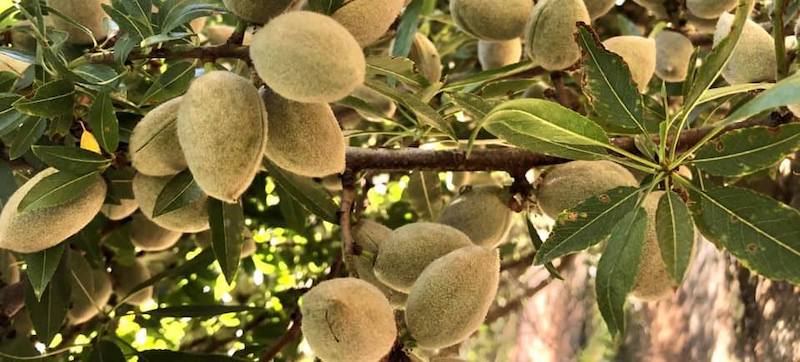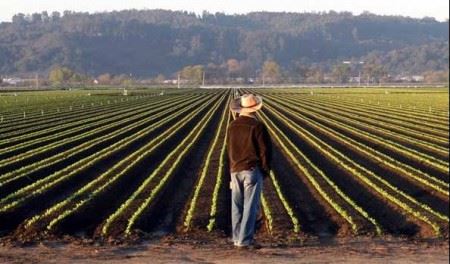Hold on to your John Deere cap — California growers are anticipating an estimated 3 billion pound almond crop this year, the largest in history.
To put this year’s harvest in perspective, California growers also produced a record almond crop in 2019. It was 2.5 billion pounds.
The growth in almond production in the Golden State is phenomenal. Growers have been adding 1 billion pounds about every 9 years. The first 1 billion pound crop came in 2002, rising to 2 billion pounds 9 years later in 2011. Fast-forward to 2020 and it looks like we’ll have a record breaking 3 billion pound crop, according to a consensus estimate among growers, the Almond Board of California and other expert sources.
“The [almond] crop this year looks phenomenal,” Fresno County Farm Bureau CEO Ryan Jacobson told ABC News Channel 30 in Fresno in late June. “Everybody would think back to February, we had the most perfect bloom that a lot of folks say in a lifetime, in a generation. There wasn’t a drop of rain,” he said.
Joe Del Bosque, who grows almonds on the Westside in the Central Valley, told me the same thing in a conversation earlier this year, commenting on the quality of the bloom on his trees at the time, and predicting 2020 could be a record crop year.
Almond trees in the Central Valley, where the majority of the California crop is grown, are heavy with almonds this year. I visited two almond orchards in late June and saw this for myself. Additionally, during recent windstorms tree branches were so heavy with nuts that many shallow-rooted trees had branches split and some even toppled over. The almond crop is so abundant this year though that the damage from the heavy winds won’t cause any significant reduction in the crop, according to growers and others.
The coronavirus pandemic, the shelter-in-place orders and shutdown of much of the U.S. economy in March hasn’t hurt sales of California almonds. For example, a recent report by University of California Cooperative Extension on the effects of the pandemic on the tree nut industry in California concluded that California almonds, walnuts and pistachios all saw significant increases in domestic shipments as Americans stocked up on shelf-stable foods during the quarantine. Data from grocery industry research firms like Nielsen and Information Resources Inc, also show sales of almonds and food and drink products containing almonds up significantly since March.
The Almond Board of California also reports that the almond business is in good shape despite the pandemic. President and CEO Richard Waycott recently said in a statement that U.S. shipments are up about 10% over the same time last year, although shipments in May declined slightly, both domestically and internationally. Exports too are up over the same year-over-year period in 2019, according to the association.
Americans have fallen in love with almonds. In the 1970s the tree nut was still a fairly exotic specialty item. But in the decades that have followed it’s become a mainstream food. Of all the tree nut varieties, almond consumption has experienced the largest growth in the U.S., increasing by nearly 1.5 pounds per person from 1970 to today, according to the USDA Economic Research Service.
The U.S. and global food and beverage industry has also embraced almonds, creating a myriad of food and drink products, like almond milk, that have helped to make California almonds one of the most popular American exports throughout the world.
Almonds have numerous health and nutritional benefits, attributes which have also aided in advancing the popularity of the tree nut crop globally. Almonds contain lots of healthy fats, fiber, protein, magnesium and vitamin E. The health benefits of almonds include helping reduce blood sugar levels, blood pressure and cholesterol levels. Research has also shown they can reduce hunger and promote weight loss.
This year’s California almond harvest begins in August and runs until October. Growers and almond industry groups are taking a positive view of the anticipated record 3 billion pound harvest, including the positives of a growing domestic market and exports, despite the coronavirus pandemic. There are some concerns though about export markets. About two-thirds of California almonds sell on export markets.
Among these concerns include the current situation in India, which is the largest single export market for California almonds. The lockdown in India due to the pandemic has caused a shortage of truck drivers, port workers and others throughout the supply chain. This in turn caused plants to operate below capacity in the country, which led to reductions in almond imports in May. The situation in India is improving though and demand there remains high for California almonds, which is a cause for optimism for growers, processors and exporters.
A more serious concern though is the ongoing trade war with China and the retaliatory tariffs China has put on U.S. crop exports. Coronavirus has slowed trade negotiations on the second phase of the trade agreement between the U.S. and China and considerable uncertainty exists in terms of where China stands on almond exports right now.
China has placed a retaliatory tariff of 55% on U.S.-grown almonds. This has resulted in a significant drop off in the volume this year in almond exports to the country, according to the Almond Board of California. In contrast, Australia, which is the biggest competitor for the U.S. with China in the almond export market, has a free-trade agreement with China. This concerns the California almond industry because China, along with India and the European Union, are the three-largest export markets for California almonds.
Almond shipments from the 2020 crop don’t begin until the fall, which allows for some time for the continued trade negotiations between the Trump Administration and China, although little is happening right now. Hopefully the administration will be able to at least settle the aspects of the agreement that pertain to farm goods because exports to China are not only crucial to almond growers but also for many other crops produced in the U.S.
The minimal carryover inventory of almonds from year to year is about 300 million pounds. This year it’s expected to be about 340 million pounds, or about two months’ worth of inventory, according to the Almond Board of California. As such, there will still be plenty of storage space available even if the trade agreement hiccups remain unresolved into the fall.
My analysis is the record 3 billion pound 2020 California almond crop, which is a whopping 17.6 percent increase over the record 2019 crop of 2.5 billion pounds, will find demand both here at home and overseas.

Domestically, consumer demand for California almonds continues to increase significantly. Additionally, sales of value-added almond-based products like almond milk, yogurts, almond butter, snacks and other products continue to show strong sales increases. Food companies too continue to develop popular new products made from almonds.
The fact more consumers are preparing food and eating at home, and will be for the rest of the year, is a major positive for almond sales as well. Prior to the coronavirus-induced shelter-in-place orders and economic shutdown, Americans split eating at-home and eating away-from-home (restaurants and other foodservice) by about 50 percent respectively. Since March though the percentage of Americans preparing food and eating at home has risen to about 70%, due in large part to the shutdown of most restaurants. Industry sales statistics have shown that almonds and almond-based products have benefited in sales from this new culinary domesticity, despite the fact that almond sales have dropped in the foodservice segment due to the shutdown.
On the export front, real challenges exist but India’s appetite for California almonds has not decreased during the pandemic. The same is true for consumer demand in China and the European Union. The supply chain issues in India will improve and I expect no decrease in the longer term when it comes to exports of California almonds to the country.
Consumer demand for almonds and almond-based products continues to increase significantly in Europe, nearly matching the U.S. in percentage growth. I see the European Union remaining a strong importer of California almonds.
The wildcard is China, although recent increases in purchases of U.S. soybeans as part of the first phase of the trade agreement between the U.S. and China is a promising sign.
Tensions between China and Australia have also flared up recently over dairy imports and exports and other trade-related issues. As such, despite the free-trade agreement between the two countries, China might want to hedge its bets and buy more California almonds this year. The big issue is the 55% retaliatory tariff China has imposed on U.S.-grown almonds. President Trump’s trade negotiators need to reach an agreement and get it, along with the other tariffs on agricultural goods, eliminated. The time is now to resolve the trade war, which hasn’t done anything positive to date for American farmers or agribusiness, as the American Farm Bureau Federation recently said in a letter to Secretary of Agriculture Sonny Perdue.
A record 3 billion pound almond crop this year would be a milestone for the California almond growers and the almond industry. There are now over 1 million almond trees in the Golden State.
The humble almond has gone from a specialty nut to a mainstream food in 5 decades. The industry will be watching sales closely this year and next, both domestically and internationally. The results in my view will largely determine the rate of growth the California almond industry follows in 2021 and in the next few years to come.
It’s important to not let production get too far out in front of demand. It’s also important to remember that two-thirds of the California almond crop goes to export countries, so it’s a crop and industry that requires relatively unfettered global free trade for its success and future growth. Protectionism isn’t good for the almond industry.
MJDOA Magazine columnist and contributing editor Victor Martino is founder/CEO of Third Wave Strategies, a marketing, sales and business development firm specializing in the food and agribusiness industries. You can contact him at [email protected].







